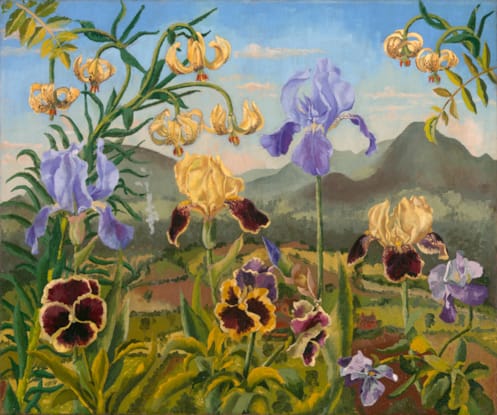Helen Layfield Bradley, MBE
(1900 - 1979)
Eh Look, Aunt Charlotte’s Gone Bright Pink
Signed and with a fly, lower left:
HELEN BRADLEY; also signed, dated 1973
and inscribed on the artist’s label attached
to the reverse
Oil on board
12 x 20 in – 30.5 x 50.8 cm
Frame size
18¼ x 26½ in – 46.3 x 67.3 cm
Inscribed on artist's label on reverse:
“Eh Look, Aunt Charlotte’s Gone Bright Pink” I said, as the new Curate took her hand and George said that Mr Taylor (the Bank Manager) was watching her. He was just about to shake hands with Miss Carter (who wore Pink), when, after seeing Aunt Charlotte turn pink and hang her head he quite forgot Miss Carter, and George, who was watching her said a tear ran down her cheek, and on our walk home from the Park she was very silent, especially when Mr Taylor walked all the way back with Aunt Charlotte and poor Mr Green (the new Curate) had to walk with Mother and the year was 1906.
HELEN BRADLEY; also signed, dated 1973
and inscribed on the artist’s label attached
to the reverse
Oil on board
12 x 20 in – 30.5 x 50.8 cm
Frame size
18¼ x 26½ in – 46.3 x 67.3 cm
Inscribed on artist's label on reverse:
“Eh Look, Aunt Charlotte’s Gone Bright Pink” I said, as the new Curate took her hand and George said that Mr Taylor (the Bank Manager) was watching her. He was just about to shake hands with Miss Carter (who wore Pink), when, after seeing Aunt Charlotte turn pink and hang her head he quite forgot Miss Carter, and George, who was watching her said a tear ran down her cheek, and on our walk home from the Park she was very silent, especially when Mr Taylor walked all the way back with Aunt Charlotte and poor Mr Green (the new Curate) had to walk with Mother and the year was 1906.
Tel.: +44 (0)20 7839 7693
Provenance
Private collection, UK;
MacConnal-Mason Gallery, London;
Private collection, UK
MacConnal-Mason Gallery, London;
Private collection, UK
Bradley was born into a comfortable middle-class family; both her grandfathers had run their own business and owned a number of terraced houses which were let to their workers. Her father bought a farm at South Shore near Blackpool which became a holiday home while their main residence, as Bradley recalls was, ‘…a tall, Victorian house on the High Street. It had long, narrow passages and steep stairs, and a large, warm kitchen with a good, black coal range with two ovens; one we called the bread oven, and in the smaller one we cooked pies, puddings etc…’ Recollections such as this give an insight into what was clearly an idyllic upbringing in an age of innocence. Yet Bradley did not begin her artistic career until the 1960s and the fact she depicts her childhood in such a vivid and captivating manner must largely be due to how drastically society had changed in the interim years. Moments such as those described in the present work were a world away from post-war Britain. It is little wonder therefore that Bradley felt the passionate need to capture an England that only existed in memory and is in an intrinsic part of her enduring appeal.
Biography
Helen Bradley was born in Lees, a village outside the industrial cotton town of Oldham. She was born just prior to the Edwardian era, a golden age, when Britain was the envy of the world, a confident wealthy superpower.
She began to paint only in her sixties in order to show her young granddaughter what life was like when she herself was a child. It was a time of prosperity and the extended family and her ‘naïve’ narrative paintings reflect this. Her works are documents of social history, always accompanied by a detailed description (see above), recording social conventions, costume, lifestyle, and portraying the growing urban sprawl. Whether she portrays an outing to Blackpool, a trip to Manchester, a day at the fair or carol singing in the snow, her paintings are full of familiar characters, Miss Carter, who always wore pink, the Aunts, and Mr Taylor the Bank Manager. Many of her works are illustrated in a series of autobiographical books, the first of which is “And Miss Carter Wore Pink, Scenes from an Edwardian Childhood”, published Jonathan Cape, London 1971. Bradley’s work was much admired by L. S. Lowry (1887-1976) and can be compared to that of the American artist, a contemporary, Grandma Moses (1860-1961).
Her works can be found in museums in: Oldham; Saddleworth and Salford.
She began to paint only in her sixties in order to show her young granddaughter what life was like when she herself was a child. It was a time of prosperity and the extended family and her ‘naïve’ narrative paintings reflect this. Her works are documents of social history, always accompanied by a detailed description (see above), recording social conventions, costume, lifestyle, and portraying the growing urban sprawl. Whether she portrays an outing to Blackpool, a trip to Manchester, a day at the fair or carol singing in the snow, her paintings are full of familiar characters, Miss Carter, who always wore pink, the Aunts, and Mr Taylor the Bank Manager. Many of her works are illustrated in a series of autobiographical books, the first of which is “And Miss Carter Wore Pink, Scenes from an Edwardian Childhood”, published Jonathan Cape, London 1971. Bradley’s work was much admired by L. S. Lowry (1887-1976) and can be compared to that of the American artist, a contemporary, Grandma Moses (1860-1961).
Her works can be found in museums in: Oldham; Saddleworth and Salford.




